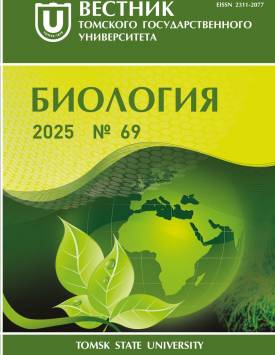The effect of the 4Th chromosome of wheatgrass with the leaf hairiness gene Hl1th in the genome of substituted lines of common wheat on adaptation to drought
Plants adapt to drought using various mechanisms, such as a developed root system and a biochemical system of antioxidant protection. Also, leaf hairiness affects the air surface stability and affects the work of the photosynthetic apparatus, transpiration and assimilation of carbon. The spring variety of common wheat Saratovskaya 29 (S29) is drought-tolerant varieties due to dense leaf pubescence and an active system of antioxidant protection from stress. In chromosome 4B of this variety carries a dominant gene for leaf hairiness Hl1, which forms a dense layer of short trichomes. In this work, S29 lines with a substitution of chromosomes 4B and 4D for chromosome 4Th from Thinopyrum ponticum (Podp.) were studied for drought adaptability. Cultivation was carried out under controlled normal growing and drought conditions in greenhouses and in vegetation chambers. The leaf hairiness contrastingly changed in the substitution lines compared to recipient. In the line S29_4Th(4B) the dense layer of short trichomes was replaced by sparse long trichomes. In the line S29_4Th(4D), rare long trichomes are located among the trichomes characteristic of the recipient. As can be seen from Table 1, the substitution line S29_4Th(4B) formed significantly more productive ears, and the line S29_4Th(4D) formed significantly more grains per plant that the recipient. This effect is observed both under conditions of normal watering and drought. The weight of 1000 grains was about 32 g in both lines under normal watering; this was similar to S29 with sufficient moisture. However, when grown in drought conditions, the grain size dropped significantly. The total grain weight from the plant did not decrease compared to S29 in line S29_4Th(4D) under drought conditions. In the normal watering it was greater. The line S29_4Th(4B) did not change the grain yield under irrigation, it was like in S29, but under drought, the grain weight from the plant slightly decreased due to a decrease in the grain size. The parameters of photosynthesis are given in Table 2. Under drought, the S29_4Th(4B) line used water more efficiently compared to S29 due to a strong decrease in transpiration and a less decrease in the rate of carbon dioxide assimilation. This property may preserve moisture in the soil and can be useful for the plant population when grown in the field under water deficit conditions. The line S29_4Th(4D) under drought practically did not reduce CO2 assimilation, but significantly increased transpiration. Therefore, the S29_4Th(4D) line will be more productive under optimal water supply conditions. The article contains 2 Tables, 10 References. The Authors declare no conflict of interest.
Keywords
common wheat, substitution line, Thinopyrum Ponticum (Podp.), leaf hairiness, trichomes, draught, photosynthesis, yield parametersAuthors
| Name | Organization | |
| Simonov Alexander V. | Institute of Cytology and Genetics SB RAS | sialexander@bionet.nsc.ru |
| Gordeeva Elena I. | Institute of Cytology and Genetics SB RAS | elgordeeva@bionet.nsc.ru |
| Osipova Svetlana V. | Siberian Institute of Plant Physiology and Biochemistry SB RAS | svetlanaosipova2@mail.ru |
| Vasenina Leleya Y. | Institute of Cytology and Genetics SB RAS; Novosibirsk State University | v.leleya@mail.ru |
| Li Wenjian | Novosibirsk State University | liw562530@gmail.com |
| Pshenichnikova Tatyana A. | Institute of Cytology and Genetics SB RAS | wheatpsh@bionet.nsc.ru |
References

The effect of the 4Th chromosome of wheatgrass with the leaf hairiness gene Hl1th in the genome of substituted lines of common wheat on adaptation to drought | Vestnik Tomskogo gosudarstvennogo universiteta. Biologiya - Tomsk State University Journal of Biology. 2025. № 69. DOI: 10.17223/19988591/69/18
